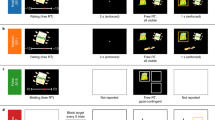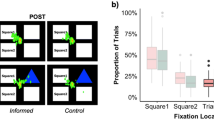Abstract
Researchers have used eye-tracking methods to infer cognitive processes during decision making in choice tasks involving visual materials. Gaze likelihood analysis has shown a cascading effect, suggestive of a causal role for the gaze in preference formation during evaluative decision making. According to the gaze bias hypothesis, the gaze serves to build commitment gradually towards a choice. Here, we applied gaze likelihood analysis in a two-choice version of the well-known Iowa Gambling Task. This task requires active learning of the value of different choice options. As such, it does not involve visual preference formation, but choice optimization through learning. In Experiment 1 we asked subjects to choose between two decks with different payoff structures, and to give their responses using mouse clicks. Two groups of subjects were exposed to stable versus varying outcome contingencies. The analysis revealed a pronounced gaze bias towards the chosen stimuli in both groups of subjects, plateauing at more than 400 ms before the choice. The early plateauing suggested that the gaze effect partially reflected eye-hand coordination. In Experiment 2 we asked subjects to give responses using a key press. The results again showed a clear gaze bias towards the chosen deck, this time without any influence from eye-hand coordination. In both experiments, there was a clear gaze bias towards the choice even though the gaze fixations did not narrowly focus on the spatial positions of choice options. Taken together, the data suggested a role for gaze in coarse spatial indexing during non-perceptual decision making.






Similar content being viewed by others
References
Bechara A, Damasio H (2002) Decision-making and addiction (part I): impaired activation of somatic states in substance dependent individuals when pondering decisions with negative future consequences. Neuropsychologia 40:1675–1689. https://doi.org/10.1016/S0028-3932(02)00015-5
Bechara A, Damasio AR, Damasio H, Anderson SW (1994) Insensitivity to future consequences following damage to human prefrontal cortex. Cognition 50:7–15. https://doi.org/10.1016/0010-0277(94)90018-3
Bechara A, Damasio H, Tranel D, Damasio AR (1997) Deciding advantageously before knowing the advantageous strategy. Science 275:1293–1295. https://doi.org/10.1126/science.275.5304.1293
Bechara A, Damasio H, Damasio AR (2000) Emotion, decision making and the orbitofrontal cortex. Cereb Cortex 10:295–307. https://doi.org/10.1093/cercor/10.3.295
Brand M, Recknor EC, Grabenhorst F, Bechara A (2007) Decisions under ambiguity and decisions under risk: correlations with executive functions and comparisons of two different gambling tasks with implicit and explicit rules. J Clin Exp Neuropsychol 29:86–99. https://doi.org/10.1080/13803390500507196
Bull PN, Tippett LJ, Addis DR (2015) Decision making in healthy participants on the Iowa Gambling Task: new insights from an operant approach. Front Psychol 6:391. https://doi.org/10.3389/fpsyg.2015.00391
Cui JF, Chen YH, Wang Y, Shum DH, Chan RC (2013) Neural correlates of uncertain decision making: ERP evidence from the Iowa Gambling Task. Front Hum Neurosci 7:776. https://doi.org/10.3389/fnhum.2013.00776
Dalmaijer E (2014) Is the low-cost EyeTribe eye tracker any good for research? (No. e585v1) PeerJ PrePrints
Fernie G, Tunney RJ (2006) Some decks are better than others: the effect of reinforcer type and task instructions on learning in the Iowa Gambling Task. Brain Cogn 60:94–102. https://doi.org/10.1016/j.bandc.2005.09.011
Fiedler S, Glöckner A (2012) The dynamics of decision making in risky choice: an eye-tracking analysis. Front Psychol 3:1–18. https://doi.org/10.3389/fpsyg.2012.00335
Franco-Watkins AM, Johnson JG (2011) Applying the decision moving window to risky choice: comparison of eye-tracking and mouse-tracing methods. Judgm Decis Mak 6:740–749
Glaholt MG, Reingold EM (2009a) The time course of gaze bias in visual decision tasks. Vis Cogn 17:1228–1243. https://doi.org/10.1080/13506280802362962
Glaholt MG, Reingold EM (2009b) Stimulus exposure and gaze bias: a further test of the gaze cascade model. Atten Percept Psychophys 71:445–450. https://doi.org/10.3758/APP.71.3.445
Glaholt MG, Reingold EM (2011) Eye movement monitoring as a process tracing methodology in decision making research. J Neurosci Psychol Econ 4:125–146. https://doi.org/10.1037/a0020692
Glöckner A, Herbold AK (2011) An eye-tracking study on information processing in risky decisions: evidence for compensatory strategies based on automatic processes. J Behav Decis Mak 24:71–98. https://doi.org/10.1002/bdm.684
Henderson JM (2003) Human gaze control during real-world scene perception. Trends Cogn Sci 7:498–504. https://doi.org/10.1016/j.tics.2003.09.006
Henderson JM, Malcolm GL, Schandl C (2009) Searching in the dark: cognitive relevance drives attention in real-world scenes. Psychon Bull Rev 16:850–856. https://doi.org/10.3758/PBR.16.5.850
Herrnstein RJ (1961) Relative and absolute strength of response as a function of frequency of reinforcement. J Exp Anal Behav 4:267–272. https://doi.org/10.1901/jeab.1961.4-267
Koop GJ, Johnson JG (2011) Response dynamics: a new window on the decision process. Judgm Decis Mak 6:749–757
Krajbich I, ArmelC Rangel A (2010) Visual fixations and the computation and comparison of value in simple choice. Nat Neurosci 13:1292–1298. https://doi.org/10.1038/nn.2635
Liao H-I, Shimojo S (2012) Dynamic preference formation via gaze and memory. In: Dolan RJ, Sharot T (eds) Neuroscience of preference and choice. Elsevier Academic Press, San Diego, pp 277–292
Liao HI, Yeh SL, Shimojo S (2011) Novelty vs. familiarity principles in preference decisions: task-context of past experience matters. Front Psychol 2:43. https://doi.org/10.3389/fpsyg.2011.00043
Morii M, Sakagami T (2015) The effect of gaze-contingent stimulus elimination on preference judgments. Front Psychol 6:1351. https://doi.org/10.3389/fpsyg.2015.01351
Nittono H, Wada Y (2009) Gaze shifts do not affect preference judgments of graphic patterns. Percept Mot Skills 109:79–94. https://doi.org/10.2466/PMS.109.1.79-94
Ooms K, Dupont L, Lapon L, Popelka S (2015) Accuracy and precision of fixation locations recorded with the low-cost Eye Tribe tracker in different experimental setups. J Eye Mov Res 8:1–24. https://doi.org/10.16910/jemr.8.1.5
Overman WH, Pierce A (2013) Iowa Gambling Task with non-clinical participants: effects of using real+ virtual cards and additional trials. Front Psycholy 4:935. https://doi.org/10.3389/fpsyg.2013.00935
Overman WH, Frassrand K, Ansel S, Trawalter S, Bies B, Redmond A (2004) Performance on the IOWA card task by adolescents and adults. Neuropsychologia 42:1838–1851. https://doi.org/10.1016/j.neuropsychologia.2004.03.014
Overman WH, Boettcher L, Watterson L, Walsh K (2011) Effects of dilemmas and aromas on performance of the Iowa Gambling Task. Behav Brain Res 218:64–72. https://doi.org/10.1016/j.bbr.2010.11.015
Park J, Shimojo E, Shimojo S (2010) Roles of familiarity and novelty in visual preference judgments are segregated across object categories. Proc Natl Acad Sci 107:14552–14555. https://doi.org/10.1073/pnas.1004374107
Peirce JW (2007) PsychoPy—psychophysics software in Python. J Neurosci Methods 162:8–13. https://doi.org/10.1016/j.jneumeth.2006.11.017
Peirce JW (2009) Generating stimuli for neuroscience using PsychoPy. Front Neuroinform 2:10. https://doi.org/10.3389/neuro.11.010.2008
Revusky SH (1963) A relationship between responses per reinforcement and preference during concurrent VI VI. J Exp Anal Behav 6:518. https://doi.org/10.1901/jeab.1963.6-518
Schotter ER, Berry RW, McKenzie CR, Rayner K (2010) Gaze bias: selective encoding and liking effects. Vis Cogn 18:1113–1132. https://doi.org/10.1080/13506281003668900
Seif Z, Daliri MR (2015) Evaluation of local field potential signals in decoding of visual attention. Cogn Neurodyn 9:509. https://doi.org/10.1007/s11571-015-9336-2
Shimojo S, Simion C, Shimojo E, Scheier C (2003) Gaze bias both reflects and influences preference. Nat Neurosci 6:1317–1322. https://doi.org/10.1038/nn1150
Simion C, Shimojo S (2006) Early interactions between orienting, visual sampling and decision making in facial preference. Vision Res 46:3331–3335. https://doi.org/10.1016/j.visres.2006.04.019
Simion C, Shimojo S (2007) Interrupting the cascade: orienting contributes to decision making even in the absence of visual stimulation. Atten Percept Psychophys 69:591–595. https://doi.org/10.3758/BF03193916
Steingroever H, Wetzels R, Horstmann A, Neumann J, Wagenmakers EJ (2013) Performance of healthy participants on the Iowa Gambling Task. Psychol Assess 25:180–193. https://doi.org/10.1037/a0029929
Toplak ME, Sorge GB, Benoit A, WestRF Stanovich KE (2010) Decision-making and cognitive abilities: a review of associations between Iowa Gambling Task performance, executive functions, and intelligence. Clin Psychol Rev 30:562–581. https://doi.org/10.1016/j.cpr.2010.04.002
Weaver MD, Lauwereyns J, Theeuwes J (2011) The effect of semantic information on saccade trajectory deviations. Vision Res 51:1124–1128. https://doi.org/10.1016/j.visres.2011.03.005
Wiener JM, Hölscher C, Büchner S, Konieczny L (2012) Gaze behaviour during space perception and spatial decision making. Psychol Res 76:713–729
Yan C, Wang R, Qu J, Chen G (2016) Locating and navigation mechanism based on place-cell and grid-cell models. Cogn Neurodyn 10:353–360. https://doi.org/10.1007/s11571-016-9384-2
Zajonc RB (1968) Attitudinal effects of mere exposure. J Pers Soc Psychol 9:1–27. https://doi.org/10.1037/h0025848
Funding
This work was supported by a YKK Leadership Scholarship from the Yoshida Foundation and a Graduate Scholarship from the Mitsubishi Corporation to N. M. Z. Further support came from Grant-in-Aid for Scientific Research 16H03751 from the Ministry of Education, Culture, Sports, Science, and Technology, Japan (MEXT). We thank Shunsuke Kobayashi and Tetsuya Matsuda for valuable comments on the research.
Author information
Authors and Affiliations
Corresponding author
Ethics declarations
Conflict of interest
The authors declare that they have no conflict of interest.
Ethical approval
Written informed consent according to APA ethical principles was obtained before the experiment. APA guidelines.
Electronic supplementary material
Below is the link to the electronic supplementary material.
Rights and permissions
About this article
Cite this article
Zommara, N.M., Takahashi, M., Ounjai, K. et al. A gaze bias with coarse spatial indexing during a gambling task. Cogn Neurodyn 12, 171–181 (2018). https://doi.org/10.1007/s11571-017-9463-z
Received:
Revised:
Accepted:
Published:
Issue Date:
DOI: https://doi.org/10.1007/s11571-017-9463-z




